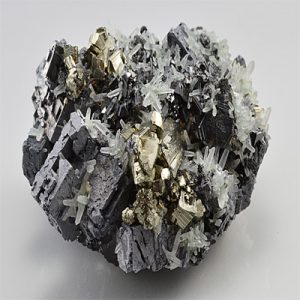Sphalerite
Sphalerite’s dispersion (fire) is about four times that of a Diamond! Because of its high dispersion, adamantine luster and incredible colors, it is one of the most beautiful of all cut gems. It is available in yellows, oranges, reds, browns, greens and black. All of these colors are due to the presence of iron. Sphalerite is an important ore of zinc and is the most abundant zinc mineral. Its zinc content is more than 64%. It is a soft and brittle gem so it is not suitable for jewelry.
The name Sphalerite is from the Greek word sphaleros meaning treacherous, because darker varieties were often mistaken for galena (lead sulfide), but yielded no lead when smeltered. Sphalerite is referred to as Blende in Europe, from the German word blenden, meaning to dazzle because of its extremely high dispersion. An iron-rich, black variety of Sphalerite is called Marmatite after its location in Marmato, Italy. A lightly colored, usually yellowish to greenish, variety of Sphalerite is known as Cleiophane and red Sphalerite has been called Ruby Blende.
The most notable source for Sphalerite is the Aliva mine, Picos de Europa Mountains, Cantabria [Santander] Province, Spain, but this source is now limited. Bright, beautiful green gems have been cut from material found in Bulgaria and Colorado. There are many localities for Sphalerite so only a few localities for the finest crystallized examples will be listed here. In Germany, from Freiberg, Saxony, and Neudorf, Harz Mountains. Colorless crystals in the Lengenbach quarry, Binntal, Valais, Switzerland. At Horní Slavkov (Schlaggenwald) and Príbram, Czech Republic. From Rodna, Romania. In England, from Alston Moor, Cumbria. At Dal’negorsk, Primorskiy Kray, Russia. From Watson Lake, Yukon Territory, Canada. In the USA, in the Tri-State district of the Mississippi Valley; near Baxter Springs, Cherokee County, Kansas; Joplin, Jasper County, Missouri and Picher, Ottawa County, Oklahoma. From the Elmwood mine, near Carthage, Smith County, Tennessee; in the Eagle mine, Gilman district, Eagle County, Colorado. In Mexico, from Santa Eulalia and Naica, Chihuahua, and Cananea, Sonora. At Huaron, Casapalca, and Huancavelica, Peru.
| Chemical Formula: | (Zn,Fe2+)S |
| Zinc Iron Sulfide | |
| Molecular Weight: | 96.98 gm |
| Composition: | Zinc | 64.06 % | Zn | ||
| Iron | 2.88 % | Fe | |||
| Sulfur | 33.06 % | S | |||
| 100.00 % |
| Crystallography: | Isometric – Hextetrahedral |
| Crystal Habit: | Crystals tetrahedral, dodecahedral, typically complex and distorted, curved and conical faces common, to 30 cm. Also fibrous, botryoidal, stalactitic, cleavable, coarse to fine granular, massive. Twinning: simple contact twins or complex lamellar forms. |
| Twinning: | Twin axis [111], twin plane {111}, simple contact twins or complex lamellar forms. |
| Cleavage: | [110] Perfect, [110] Perfect, [110] Perfect (perfect dodecahedral) |
| Fracture: | Conchoidal, Uneven |
| Tenacity: | Brittle |
| Moh’s Hardness: | 3.5 – 4.0 |
| Density: | 3.9 – 4.2 (g/cm3) |
| Luminescence: | Fluorescent, yellow-orange under SW UV and LW UV; Triboluminescent |
| Radioactivity: | Not Radioactive |
| Other: | Pyroelectric |
| Color: | Colorless, Yellow, Orange, Red, Green, Brown, Black; often zoned (highly variable) |
| Transparency: | Transparent to Translucent; Opaque when iron-rich |
| Luster: | Adamantine, Resinous |
| Refractive Index: | 2.37 – 2.43 Isotropic |
| Birefringence: | 0.00 (Isotropic) |
| Dispersion: | 0.156 (extremely high) |
| Pleochroism: | n/a |
| Anisotrophism: | May show strain-induced birefringence. |


